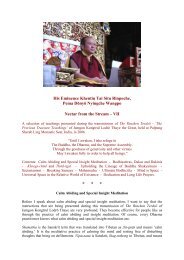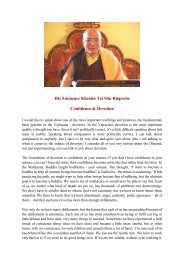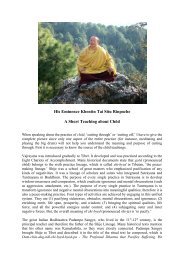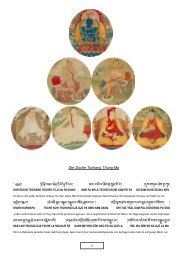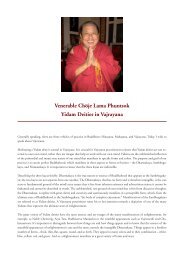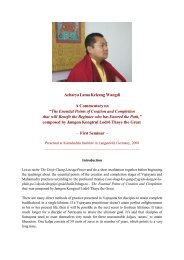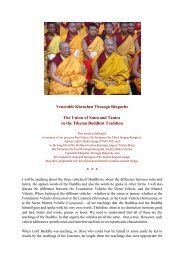Acharya Lama Kelzang Wangdi White Arya Tara - Karma Sherab Ling
Acharya Lama Kelzang Wangdi White Arya Tara - Karma Sherab Ling
Acharya Lama Kelzang Wangdi White Arya Tara - Karma Sherab Ling
Create successful ePaper yourself
Turn your PDF publications into a flip-book with our unique Google optimized e-Paper software.
is a more direct way. Sutrayana practice is working in an indirect way, which is a long way.<br />
Therefore the texts state that to become completely enlightened like a Buddha by practicing<br />
the long Sutrayana way takes three countless aeons, roughly speaking. One might feel better<br />
working in an indirect way and might feel scared of working in a direct way. Going the long<br />
way means that we have to work hard. It’s like driving the long way; we become exhausted<br />
when we drive the long way. Sutrayana practice is like that; there are many things to do, lots<br />
of meditation to do, and lots of work to do for a long time. Vajrayana is working in a direct<br />
way, in an express way, and the practice of <strong>White</strong> <strong>Arya</strong> <strong>Tara</strong> is the express way. It’s important<br />
to understand the express way, like driving down the Autobahn (‘freeway’), therefore I will<br />
explain it a little bit. Let me first speak about what practicing Sadhana in general means.<br />
Sadhana practice is the Vajrayana liturgy and procedure for really engaging in the practice.<br />
We call it “yidam practice.” The yidam is our tutelary deity, our personal aspect of<br />
enlightenment. We aren’t really engaged in practice if we just recite the Sadhana of a yidam<br />
and don’t really care. We should practice the Sadhana wholeheartedly, keeping it in mind<br />
very clearly. We try to have as clear a picture of the yidam as possible in our mind while<br />
engaging in the Sadhana practice. For example, when we are in front of a buffet with a<br />
sumptuous variety of food, we taste the essence of everything very clearly. In the same way,<br />
when we engage in Sadhana practice, we feel like we are taking in the energy of the many<br />
sorts of food on the buffet. Having tasted a little bit of everything, we know, “Oh, that was<br />
vegetable, that was fish, that was chicken meat,” and so forth and everything is okay.<br />
In Vajrayana, we don’t search and think, “I might achieve the results of practice sometime in<br />
the far future.” Vajrayana means practicing the results (i.e., the qualities of a Buddha) while<br />
practicing the path. We do this by actually being or having the qualities right now. For<br />
example, it’s presently the Christmas season. A Sutrayana practitioner thinks about going to<br />
the Christmas market downtown and about looking at all the nice things that are being sold in<br />
the booths and stands. As Vajrayana practitioners, we don’t think of going to the Christmas<br />
market, rather, we are actually there and are enjoying it, i.e., we experience the presence of all<br />
qualities in us right now. In Vajrayana, we don’t think that we are becoming <strong>White</strong> <strong>Tara</strong> when<br />
we engage in the practice, rather, we think that we are <strong>White</strong> <strong>Tara</strong>. Her appearance, her eyes,<br />
and her ornaments symbolize her enlightened qualities and they really shine out, like all the<br />
lights at the Christmas market. So, we need to understand the view when we practice<br />
Vajrayana, not with the intention of finding something outside ourselves, but to be able to<br />
enjoy the state of being <strong>White</strong> <strong>Tara</strong>.<br />
When we deeply think that we are <strong>White</strong> <strong>Tara</strong>, we don’t think that we are normally not <strong>White</strong><br />
<strong>Tara</strong>, are wearing her mask and need to act like she does. It’s not like thinking that we aren’t<br />
Michael Jackson when we try to dance like he danced – it’s not like that. We aren’t putting on<br />
the mask of <strong>White</strong> <strong>Tara</strong> and don’t put on an act, rather, we recognize what we are when we<br />
engage in the practice. When we deeply think that we are <strong>White</strong> <strong>Tara</strong>, we connect with her<br />
energy, which is the basic seed of our Buddha nature that we all have. We see the qualities of<br />
Buddha nature that are within us when we recognize that we are <strong>White</strong> <strong>Tara</strong>. We don’t have<br />
to wear a mask and don’t have to act it.<br />
In Vajrana practice, it’s very important to have the pride of being the deity. We call this “vajra<br />
pride.” We aren’t artificial but are really sure that we are <strong>White</strong> <strong>Tara</strong>. We trust, have full<br />
confidence, and know, “I am <strong>White</strong> <strong>Tara</strong>.” Even if the Buddha came and, although he would<br />
only be joking, he said, “You aren’t <strong>White</strong> <strong>Tara</strong>. You don’t act like she does,” we wouldn’t<br />
believe him but are certain that we are <strong>White</strong> <strong>Tara</strong>. Having vajra pride means knowing what<br />
we are, and it’s very important in Vajrayana practice. Thinking like that with confidence, it’s<br />
2



